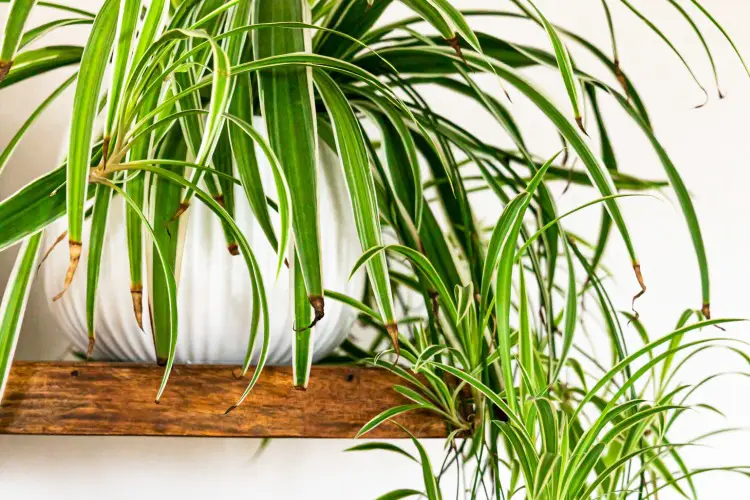
Nobody likes seeing Spider Plant brown tips. There are 5 reasons for Spider Plant leaf tips turning brown. In this blog post I will cover all of the reasons for Spider Plant turning brown, their causes and solutions.
The most common reasons for brown tips on Spider Plant leaves are:
- Stress from overwatering or under-watering
- Fluoride content in water
- Fertilizer residue and salt build-up
- Low humidity levels
- Too much sun exposure
- Diseases
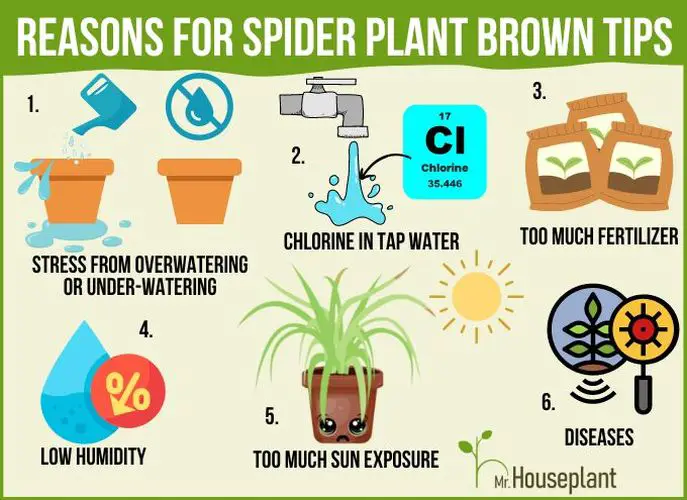
These six reasons are the most common when it comes to Spider Plant brown tips
Spider Plants are popular indoor plants that can grow healthy and strong in sub-optimal growing conditions inside your home if you provide them with the necessary care. They can commonly thrive without much effort, but it’s not uncommon to notice brown tips on Spider Plants.
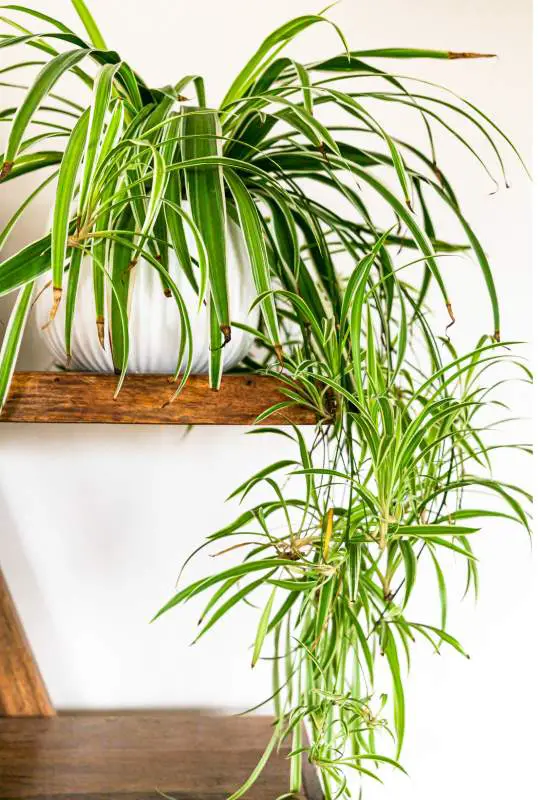
Spider Plants can get brown tips from different causes, although most are not harmful to your plant
Although these issues are common, they are treatable if you know what to do. However, you should be aware that Spider Plant brown tips are just a cosmetic issue, and they won’t affect the health of your plant unless a disease causes them.
Look at the detailed explanations below to learn what can be the cause and to get tips on preventing them on your Spider Plants.
Stress from Overwatering or Under-Watering
Water stress can occur when you overwater or under-water your Spider Plant, slowly leading to Spider Plant tips turning light or dark brown.
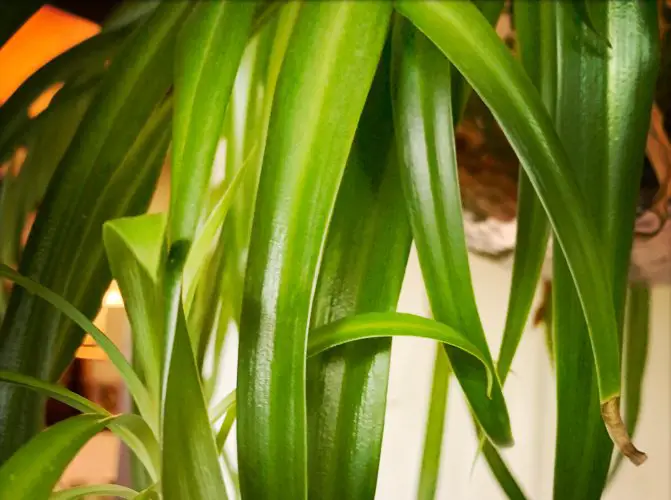
It’s likely to get brown tips on your Spider Plant Chlorophytum Comosum if you overwater or underwater the plant
When the issue is caused by overwatering, the excess water can lead to root rot, preventing water flow and nutrients from reaching your plant. Because of that, Spider Plant leaves can get brown tips. Excess water could kill your house plant if you don’t react promptly.
If this happens and the root rot is already spread, you’ll need to get rid of rotten areas from the root system to try to save your plant. However, if the problem is extensive, your plant might not make it. After removing the rotten sections caused by root rot, repot the plant using well-draining soil and a pot with enough drainage holes.
When the problem is under-watering, the leaves on your Spider Plant will eventually dry out from too dry soil. Spider Plant prefers that you let the soil dry out between waterings, but if it’s without water for too long, you could notice browning tips. If they occur due to under-watering, you can evaluate the plant’s soil and the level of moisture inside the container, ensuring you provide the plant with an adequate water supply.
This may raise questions about when to water your plant to avoid having to deal with water stress in the first place. You should water as soon as the Spider Plant’s soil fully dries out, to the bottom of the pot, make sure not to wait too long after that.
Read the caption in the Instagram post below for info on how not to overwater your Chlorophytum Comosum.
Fluoride Content in Water
Another common thing that can cause Spider Plant tips turn brown is fluoride content in tap water. When exposed to fluoride for an extended period, Spider Plants can get brown leaf tips. To prevent potential fluoride toxicity, it’s best to use distilled water or rainwater instead of tap water for watering your Spider Plant.
Other than making the tips of your Spider Plant turn brown, fluoride collects inside the plant and starts to threaten its overall health. Fluoride toxicity will decrease the process of photosynthesis inside your plant and damage the plant’s tissue. Eventually, your Spider Plant’s leaves will turn brown, so you should inspect your tap water.
If your Spider Plant’s browning tips are caused by fluoride toxicity, you should repot your Spider Plant or use distilled water to flush out the soil by following these steps:
- Water Spider Plants with several cups
- Wait for a couple of minutes for the fluoride to dissolve in the soil and for the water to drain out
- Once the potting mix drains, repeat the same process several times
If you don’t have distilled water, you could use rainwater to flush the excess fluoride from the plant’s soil.
As you can see, water quality is important not only for you but your indoor spider plant as well.
Fertilizer Residue and Salt Build-Up
Salt build-up from fertilizer can also lead to brown leaf tips in Spider Plants. If you use too much fertilizer on your Spider Plant, you could cause unintentional toxicity, which could damage the plant’s roots and lead to leaves turning brown.
If your brown leaf tips issue comes from applying excess fertilizer, you can repot Spider Plant in a fresh potting soil mix, like Mother Earth Groundswell. You could also stop fertilizing and flush the soil to remove excess salts. Typically, you don’t need to fertilize your Spider Plant if you repot it annually.
Low Humidity Levels
Like most tropical plants, Spider Plants love humidity, but they can adapt to lower levels easily. However, when exposed to extremely low humidity levels, the leaf tips on Spider Plants can become dry and brown.
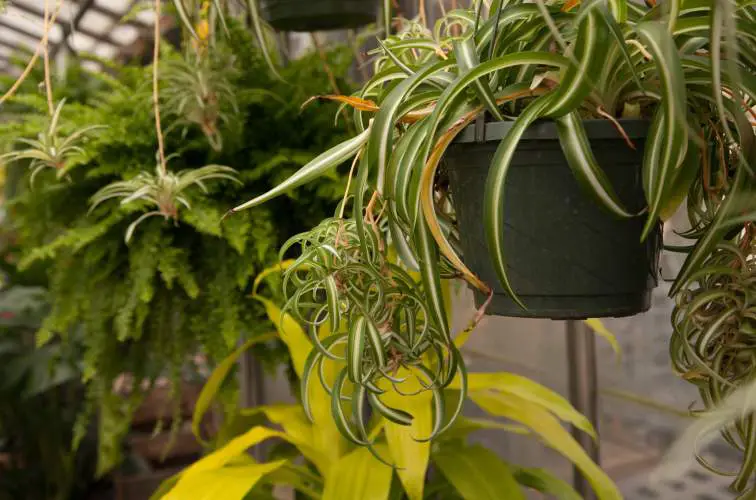
The Spider Plant likes humidity, and a lack of it can make its tips turn brown; maintain humidity levels in your home to avoid brow leaf tips on plants
Too Much Sun Exposure
If you grow your spider plant outdoors, in your garden, avoid direct sunlight and keep it in shade. Outdoor shade is the same as bright indirect light indoors. A spider plant can tolerate a few hours of direct sunlight, but if it is not gradually adjusted to it, it can lead to spider plant turning brown.
Another problem with direct sunlight is that it will lead to the soil drying out much faster. This can also lead to brown tips. Make sure to move the plant to shade to prevent this from happening.
For indoor Spider Plant, keep it in bright indirect light. It can tolerate low light, but for a healthy plant bright light is the best.
Diseases
Last but not least, diseases can also be why your Spider Plant’s leaves are browning. Bacterial leaf blight is a common cause of Spider Plant brown tips.
If Spider Plants get infected with leaf blight, the Spider Plant leaves will slowly become brown and eventually turn black. Overly humid and hot conditions frequently result in bacterial leaf spots.
However, this disease is treatable, and you can cure your plant if the stems are not affected. To prevent leaf blight from spreading to other parts of your plant, you’ll need to prune off the diseased foliage. It’s also helpful to keep away from overhead watering.
If the disease has already spread onto the stems, you’ll need to eliminate your plant as it could put your other plants in danger. It’s always better to get a new Spider Plant than to risk losing other precious plants.
Should I Cut the Brown Tips Off My Spider Plants?
If the brown leaf tips on your Spider Plant are not caused by a disease, you can prune them off, but it’s not something you necessarily have to do. It’s more of a personal preference because, again, it’s just a cosmetic and aesthetical issue rather than an actual health-threatening problem.
You should cut off the Spider Plant brown tips if a disease is the cause. To do that, you should cut off the brown tips of the affected leaves, along with healthy leaf tissue. That way, you can ensure that all diseased sections will be removed from the plant.
Before you make the cut, sterilize the pruning tools to prevent the disease from spreading on healthy foliage. If your pruning tools touch the diseased leaf part when cutting, ensure to sterilize them before making a new cut.
Can I Use Filtered Water Instead Of Distilled Or Rainwater?
You cannot use filtered water instead of distilled or rainwater. Different filters will remove some of the minerals from the water, but in most cases it will be difficult to determine what was filtered out exactly. You won’t know whether fluoride was actually removed or not and in which quantity. By using distilled water or rainwater you will be using fluoride-free water.
How to Take Care of the Brown Tips on My Spider Plant / How To Fix Them?
To fix the brown tips on your Spider Plant, you must find the cause behind the browning issue. Typically, most causes are non-harmful for your plant, as the tips on Spider Plants can turn brown from environmental conditions.
If you’re bothered by these tips, it’s best to prune them off, following the steps in the article. That way, you’ll resolve the browning issue, regardless of the cause.
Houseplant care and gardening can be easy if you have the right knowledge. If you are struggling with any houseplants, need care tips, or have any houseplant care questions, feel free to schedule a consultation. Or write a comment below.
Yours Truly,

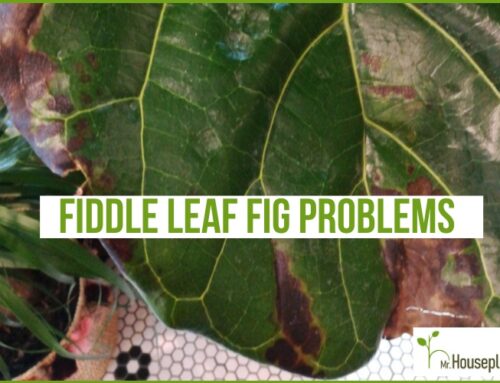
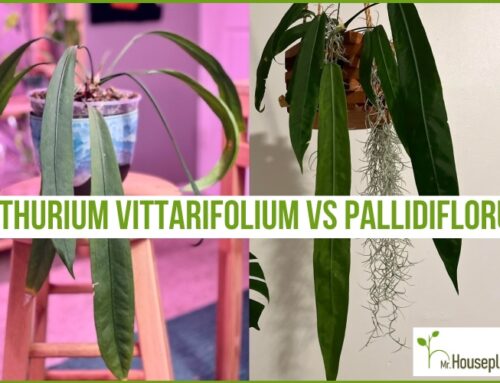
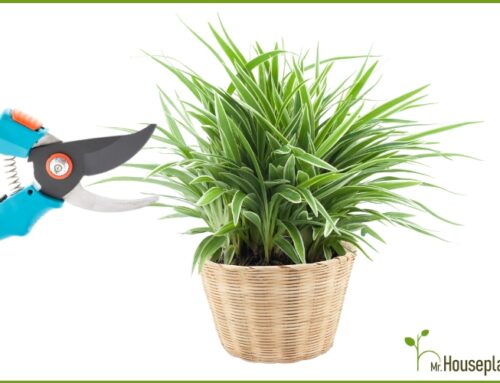


Thank you very helpful
You’re very welcome Karen 😊
Very good tips,,,thank you,,
You’re welcome Suzanne 😊